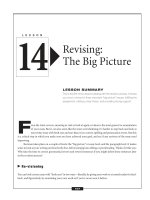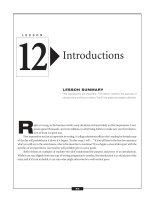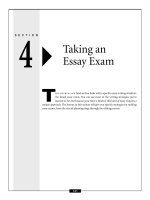Write Better Essays - Introductions
Bạn đang xem bản rút gọn của tài liệu. Xem và tải ngay bản đầy đủ của tài liệu tại đây (111.03 KB, 12 trang )
R
ight or wrong, in the business world, many decisions are based solely on first impressions. Com-
panies spend thousands, and even millions, in advertising dollars to make sure your first impres-
sion of them is a good one.
First impressions are just as important in writing. A college admissions officer who’s reading his fortieth essay
of the day will probably put it down if it begins, “In this essay, I will . . .” If you tell him in the first few sentences
what you will say in the next dozens, what is his incentive to continue? If you begin a science lab report with the
specifics of an experiment, your teacher will probably give it a poor grade.
Both of these are examples of students who don’t understand the purpose and power of an introduction.
While it can vary slightly from one type of writing assignment to another, the introduction is a critical part of the
essay, and if it’s not included, it can ruin what might otherwise be a well-written piece.
LESSON
Introductions
LESSON SUMMARY
First impressions are important. This lesson explains the purpose of
introductions and how to write a “hook” that grabs the reader’s attention.
12
93
What an Introduction Should Do
A combination of courtesy and strategy, the introduction “sells” the essay to the reader, compelling him or her to
read the rest of it. For most assignments, it should also acquaint the audience with the subject and purpose of the
essay. Specifically, essay writers have four tasks to accomplish within the first paragraph or two. An effective intro-
duction should:
1. Provide the context necessary to understand your thesis. When you’re writing for a general audience,
your readers don’t know who you are. They may not know your assignment and may not be familiar with
the issues or texts you are discussing. Thus, you might need to provide background information. If you are
writing about literature, you should include the titles, authors, and publications dates of the text you are
analyzing. Similarly, if you’re writing about a historical event, you should name the event, the date, and the
key people (or countries, or issues) involved. Here’s an example:
Mary Shelley’s novel Frankenstein was published over 180 years ago. But this remarkable novel raises a ques-
tion that is more important today than ever: What is a creator’s responsibility for his or her creation?
2. Clearly state the main point of the essay. Your readers should know from the beginning what idea you will
be developing throughout the essay. A clear thesis statement is a key component of an effective introduc-
tion. (See Lesson 9 for a review of thesis statements.) In the previous example, the last sentence expresses
the main idea of the essay—the question, and its relevance today.
The exception to this rule is the college application essay. Because of the high volume of essays each
admissions officer must read, it makes sense to stand out, and keep his or her attention, by being mysteri-
ous in your introduction. Make him or her read on to the second paragraph by not revealing your subject
until then.
Here’s an example:
I will never forget the moment I landed in Rio de Janeiro, Brazil. As the plane descended, I was awed by the
dynamic geography and the juxtaposition of the sea, the mountains, and the city’s skyline. I absorbed the land-
scape further and my eyes focused on the favelas mounted on the hillsides.
This introduction works well on a number of levels: It takes the reader to an exotic location, describing the
landscape and setting the scene. The writer tells you the moment is unforgettable, and brings you along
with her. But, most importantly, she does not reveal anything about her subject. You have to read on to
find out what her essay is about.
3. “Hook” the reader. The introduction should not only get the reader’s attention, but compel him or her to
keep reading. The next section examines some of the many ways to write a successful hook.
–INTRODUCTIONS–
94
4. Set the tone for the essay. Tone refers to the mood or attitude conveyed through language, particularly
through word choice and sentence structure. Your tone may be personal and informal, serious and formal,
urgent, relaxed, grave, or humorous. In the Frankenstein example, the language is serious and formal, and
it fits the serious subject (supporting examples in the essay include discussions of atomic weapons and
cloning).
Ways to Grab Your Reader’s Attention
A good hook contains an element of creativity and an awareness of the reader’s needs. It doesn’t simply announce
the subject or thesis, or make generalizations that sound clichéd. Phrases such as one step at a time; no news is good
news; have a nice day; when life gives you lemons, make lemonade; and no guts, no glory are so overused they have
little or no meaning.
The following seven introductory hook strategies offer specific ways to get into your subject and thesis that
arouse a reader’s attention, making your introduction an invitation to read on. These strategies are:
1. a quotation
2. a question
3. a surprising statement or fact
4. an imaginary situation or scenario
5. an anecdote
6. interesting background information
7. a new twist on a familiar phrase
A Quotation
Start with a quote from a text, a film, a subject-matter expert, or even a friend or relative if he or she said some-
thing relevant to the topic and of interest to your reader.
“All animals are equal, but some animals are more equal than others,” said Napoleon in George Orwell’s classic novel
Animal Farm. Uncle Sam might say something similar: “All people must pay taxes, but some must pay more taxes than
others.” Our current federal income tax system treats taxpayers unfairly and requires and monumental budget to admin-
ister and maintain. A flat tax, which would treat all taxpayers equally and dramatically reduce tax compliance cost,
is the answer.
A Question
Open up with a question to get your readers thinking. Of course, the question (and its answer) should be rele-
vant to your thesis.
What’s in a name? Nothing—and everything. It is, after all, just a name, one tiny piece of the puzzle that makes up a
person. But when someone has a nickname like “Dumbo,” a name can be the major force in shaping one’s sense of self.
That’s how it was for me.
–INTRODUCTIONS–
95
You’re writing not only to show off your writing skills, but also to sell yourself to the admissions officer
(your reader). It doesn’t make sense to reveal unflattering or potentially damaging information about your-
self. It is the reader’s job to select candidates who are not only smart enough, but also emotionally sta-
ble enough to stay in school and do well for four years. They’ll probably reject you if you give them reason
to believe you might not be able to handle college. While the hook of the essay about seeing a psy-
chiatrist is well done, it’s not the kind of material that works for the application essay.
A Surprising Statement or Fact
This type of hook provides “shock value” for the reader.
If you don’t believe our current tax law is ridiculously out of control, consider this: Our total tax law consists of 101,295
pages and 7.05 million words. That means our tax law has almost 100 times more pages and ten times as many words
and the Bible. Bloated? You bet. But it doesn’t have to be. The government would collect equal or greater tax revenue
and save millions of dollars in compliance costs by instituting a flat tax system.
Practice 1
On a separate sheet of paper or on your computer, write an introductory hook for one of the essays you brain-
stormed or outlined in an earlier lesson. Use a quotation, a question, or a surprising statement or fact.
An Imaginary Situation or Scenario
Hook your readers with your imagination. You might ask them to place themselves in the scene, or you can let
them simply witness it.
You’ve been drifting at sea for days with no food and no water. You have two companions. Suddenly, a half-empty bot-
tle of water floats by. You fight over the bottle, ready to kill the others if you have to for that water. What has happened?
What are you—human or animal? It is a question that H.G. Wells raises over and over in The Island of Dr. Moreau.
His answer? Like it or not, we’re both.
An Anecdote
Start your essay by telling a short, interesting story related to your subject.
I’d been getting into a lot of trouble—failing classes, taking things that didn’t belong to me. So the guidance counselor
at school suggested that my parents take me to a psychiatrist. “You mean a shrink?” my mother replied, horrified. My
father and I had the same reaction. After all, what good would it do to lie on a couch while some “doctor” asked ques-
tions and took notes? So I went to my first session angry and skeptical. But after a few weeks, I realized that we had it
all wrong. Those shrinks really know what they’re doing. And mine helped me turn my life around.
–INTRODUCTIONS–
96
Another Word about College Application Essays
Interesting Background Information
Tell your reader something unusual about your subject. Here’s a revision of the Frankenstein introduction using
this strategy:
Incredibly, Frankenstein—one of the most important novels in Western literature—was written by a teenager. When
it was published in 1818, Mary Shelley was only 19 years old. Despite her youth, Shelley’s story raises a question that
is more important today that ever: What is the creator’s relationship to his or her creation?
A New Twist on a Familiar Phrase
Reword or rework an old standard to create a fresh hook.
To eat or not to eat? That is the question millions of Americans struggle with every day as they fight the battle of the
bulge. But it seems to be a losing battle. Despite the millions spent on diet pills and diet plans, Americans today are
heavier than ever.
There are many reasons for this nationwide weight gain, but experts agree that the main cause is lack of exer-
cise. And one of the reasons we don’t get enough exercise is because we spend too much time in front of the TV.
Notice that this introduction is actually two paragraphs. In some essays, the introduction runs three or even
four paragraphs. The key is to have an introduction that is in proportion with the rest of the essay. If your essay
is two pages long, one paragraph is probably sufficient for the introduction. If it goes longer, the body of your essay,
where you develop your main points and support them with evidence and examples, will lack the room it needs
to completely state your case. But if your essay is ten or twelve pages long, it may take a couple of paragraphs to
properly introduce your topic and thesis. You might have a more detailed anecdote, for example, or spend two or
three paragraphs describing a scenario that sets up your thesis.
Practice 2
Write a two-paragraph introduction for one of the essay examples provided in the first half of this book. Use one
of these strategies: an imaginary situation or scenario, an anecdote, interesting background information, or a new
twist on a familiar phrase.
In Short
Introductions serve an important function. They “welcome” your reader into your essay by providing context,
stating your thesis, and setting the tone. They should also grab your reader’s interest. Strategies for attention-
grabbing hooks include starting with a quotation, a question, a surprising statement or fact, an imaginary situ-
ation or scenario, an anecdote, interesting background information, or a new twist on a familiar phrase.
–INTRODUCTIONS–
97









